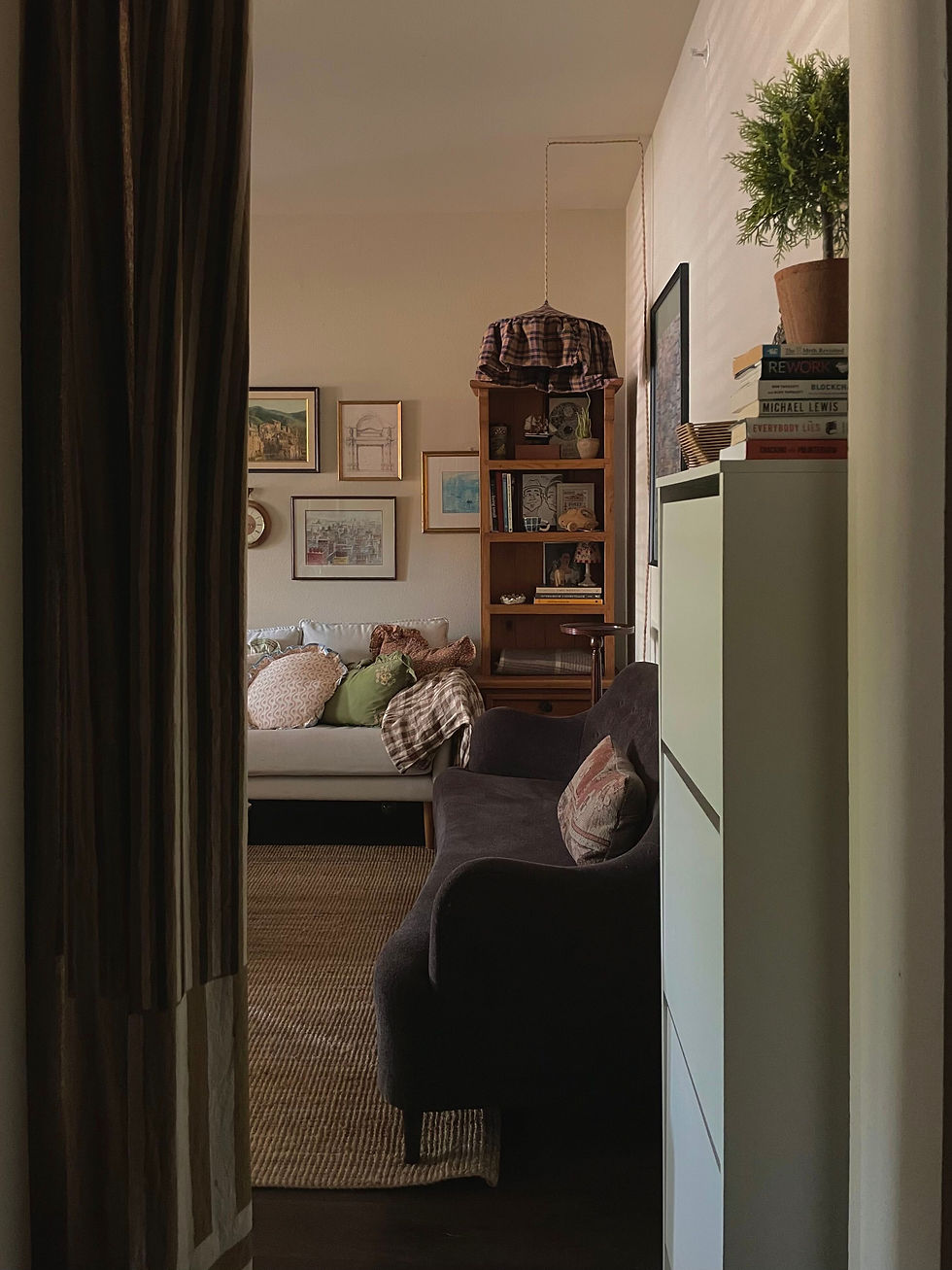Storytelling through Design: Creating a Home that Speaks
- Hannah Susan

- Aug 18
- 4 min read
Our home is a small-sized, thoughtfully designed space — where every piece has a story and every corner continues to be designed with care. From secondhand finds that bring history into our space to creative multifunctional pieces that make the most of every inch, this journey is about more than just decorating — it's about creating a home that feels warm, lived-in, and truly loved.

Having lived in different countries, home has always been a safe haven where I surround myself with memorable photographs, objects that have a deep personal meaning, art that reminds me of an experience or colors that take me back to my cultural roots. And though we might think that these are just mere objects, they somehow also have the power to make us feel grounded and connected to all of those loved ones and memories that we hold onto. This is how your home becomes a reflection of you.
Every home has a story to tell. The way we design our spaces goes beyond aesthetics — it’s about crafting a visual narrative that reflects our journey, personality, and memories. Whether through cherished heirlooms, collected vintage finds, or intentional color choices, design is a form of storytelling.
In this post, we’ll explore how to infuse storytelling into your home’s design — creating a space that feels authentic, meaningful, and uniquely yours.
every piece has a story
A well-designed home isn’t just about following trends; it’s about surrounding yourself with objects that hold personal significance.

How to Curate Meaningful Pieces:
Mix Old & New – Vintage furniture, inherited decor, or travel keepsakes add history and depth.
Tell Your Journey – Display items that reflect your experiences - books, artwork, and textiles with a story.
Let Your Walls Speak – Use gallery walls, framed letters, or travel photos to create a visual timeline of your life.
Example: Instead of buying mass-produced art, frame handwritten recipes from a loved one or vintage postcards from places you’ve visited.
colors, textures, layers as a narrative tool
Design isn’t just about objects — it’s about the feeling a space evokes. Colors, textures, and layering help shape the mood and story of a room.

Ways to Use These Elements in Storytelling:
Color Psychology: Soft earth tones create warmth and nostalgia, while deep blues or greens can evoke a sense of history and depth.
Layered Textures: Combining velvet, linen, reclaimed wood, or aged metals adds richness to a space.
Contrast for Character: A sleek modern table paired with antique chairs tells a story of past meeting present.
Example: A cozy reading nook with a worn leather chair, a vintage lamp, and a stack of well-loved books tells a story of comfort and nostalgia.
// Embracing slow design allows you to curate pieces that hold sentimental value rather than just filling a space for the sake of completion.
designing for emotion and atmosphere
A home should feel like you — not just look beautiful. The right design choices can create an atmosphere that evokes specific emotions.

How to Set the Mood in Your Home:
Lighting: Warm, dim lighting fosters intimacy, while natural light enhances openness and energy.
Furniture Placement: Arranging furniture for conversation and comfort makes a space more inviting and personal.
Scent & Sound: Candles, diffusers, or a record player can trigger memories and create a sensory experience.
Example: A well-loved dining table with mismatched chairs and candlelight tells the story of shared meals and meaningful conversations.
the art of collecting and curating
A truly personal home isn’t built overnight — it’s collected over time. Embracing slow design allows you to curate pieces that hold sentimental value rather than just filling a space for the sake of completion.
Tips for Thoughtful Curation:
Thrift & Antique Shop: Look for pieces with character - something that sparks a memory or an emotional connection.
Repurpose & Upcycle: Restore old furniture or transform heirloom items into modern treasures.
Let It Evolve: Your home’s story should grow with you - don’t rush to "finish" a space too quickly.
/ from left to right: a bowl holding old photographs, personal stamp collection, a poem written to my husband displayed over books
Example: A vintage sideboard found at a flea market might have its own history, but when styled with family photos and collected ceramics, it becomes part of your story too.
closing thoughts
Your home should feel like a well-loved book, with every room telling a different chapter of your story. Whether through collected treasures, intentional design choices, or the simple way light filters through your favorite corner, your space should reflect who you are and what you love.
So, next time you decorate, ask yourself: Does this space tell my story?
Design Reflection: How does your home reflect your journey? Share your thoughts in the comments or tag @_collectedspaces on Instagram - we’d love to see your storytelling through design!












Comments